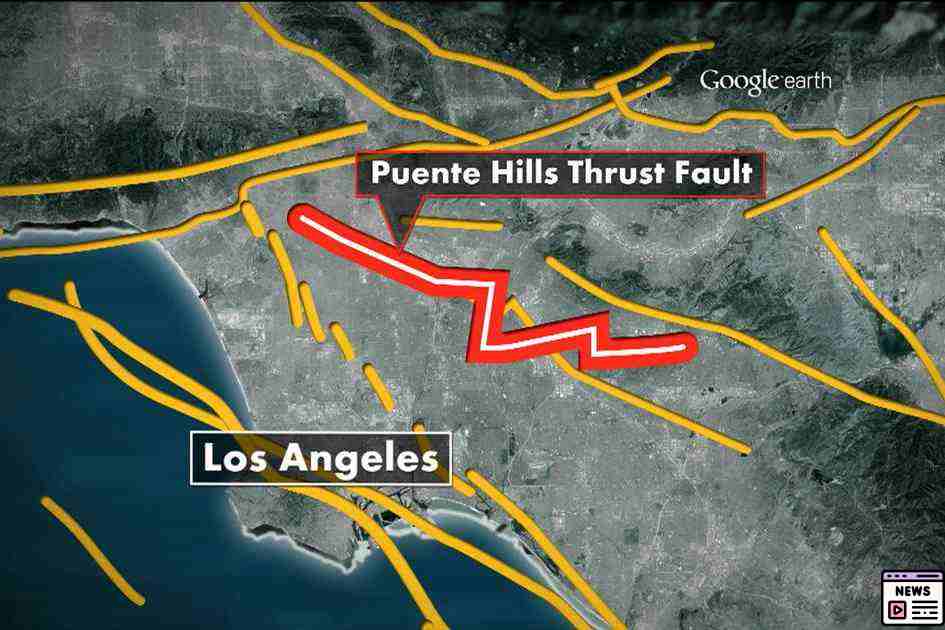Updated on: October 9, 2024 10:15 am GMT
Puente Hills Fault: A Hidden Earthquake Threat to Los Angeles
Located beneath the dynamic and densely populated neighborhoods of Los Angeles lies a fault system that experts warn could pose a more significant earthquake risk than the infamous San Andreas Fault. The Puente Hills thrust fault is situated directly under residential areas in northeast Los Angeles, including cities like Pasadena, raising concerns about the potential impact of a major quake in the near future.
The Risk Beneath Our Feet
The Puente Hills fault system has been largely overshadowed by the San Andreas fault in public consciousness, but it presents a unique set of dangers. Unlike the San Andreas, which is well-known and studied, the Puente Hills fault runs through populated areas, heightening the stakes. While there has been extensive research on the San Andreas, the Puente Hills fault, and its potential for significant earthquakes, has not received the same level of attention.
Understanding the Fault System
The Puente Hills fault system is classified as a thrust fault, which means it is capable of producing powerful earthquakes. According to seismologists, the fault has the capacity to generate earthquakes of magnitude 7.0 or greater, which could have devastating effects on the infrastructure of the surrounding area.
Geological Concerns
Experts indicate that the fault has been quiet for a long time, which can be a worrying sign in the world of geology. The longer a fault remains inactive, the greater the tension that builds up, leading to a higher likelihood of a significant quake when it finally does release. Some estimates suggest that a quake along the Puente Hills fault could produce damage comparable to the 1994 Northridge earthquake.
Are We Prepared?
The question looms large: is Los Angeles prepared for a potential earthquake that could leave extensive damage in its wake? Many buildings in crucial areas lie unretrofitted, raising concerns about their ability to withstand a significant seismic event. In an earthquake-prone state like California, retrofitting buildings is vital for safety; however, many older structures remain vulnerable.
Testing Earthquake Resilience
To better understand the risks posed by such faults, experts from various institutions have been studying the earthquake resilience of buildings. Scripps News recently explored one of the world’s leading facilities focused on testing buildings’ ability to withstand earthquakes. By simulating seismic events, researchers are working to identify weaknesses in structures, thereby informing designs that prioritize safety and resilience.
Advancements in Safety Measures
While advancements have been made in building codes and designs, the rush to develop and expand in densely populated areas poses challenges. Compliance with updated regulations is essential, yet many buildings, especially older ones, may not meet current standards. This discrepancy highlights the importance of consistent inspections and retrofitting where necessary.
Looking Ahead
As Los Angeles continues to grow, the Puente Hills fault serves as a stark reminder of the natural risks the city faces. The juxtaposition of urban development and geological threats necessitates increased awareness and preparation. Community engagement, educational initiatives, and effective infrastructure planning are critical components in mitigating the potential impact of a major earthquake.
The Importance of Community Awareness
Residents and local authorities must remain informed about the risks associated with living above fault lines. Preparedness programs that include earthquake drills and educational resources can significantly reduce the injury and damage that comes with earthquakes. Understanding what to do before, during, and after an earthquake can make a difference in ensuring safety.
Gathering Data and Insight
In addition to enhancing preparedness, ongoing research into fault systems like the Puente Hills is critical. Analyzing seismic patterns and utilizing technology to track fault movements can provide essential data, allowing scientists to predict potential activity. This information can aid in risk management and inform urban planning initiatives.
Conclusion
The Puente Hills fault may not be as recognizable as the San Andreas fault, but its potential consequences could be equally dire for Los Angeles. As experts continue to study this underestimated threat, the focus must remain on preparing residents and infrastructure to withstand whatever the Earth may bring.
To learn more about how to be ready for earthquakes and stay safe, check out the California State Government website.
